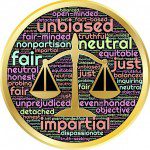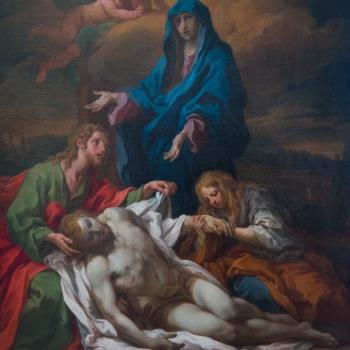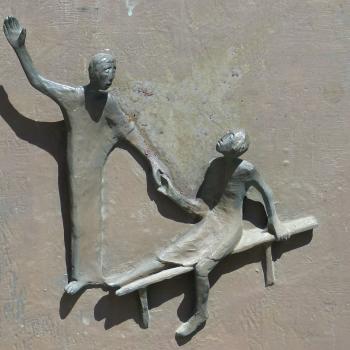Essay number 3 of 4
Both society, as an entity, and the person, as an individual, are entitled to protect themselves. But the balance between taking that into one’s own hands versus depending on law enforcement officers is a tenuous one. Even the term “law enforcement officer” rather than “peace officer” alerts us to how easy it is to toggle between radically different emphases.
Mostly, justice has been a system whereby powerful elites have controlled and exploited the masses by
- Creating the laws – legislators
- Interpreting the laws – judges
- Enforcing the laws – police officers and military; and
- Punishing infractions of the laws – “correctional” officers.
Inevitably these elites have appealed to some superhuman order as the origin and justification for their “laws.” In the case of theocracies, or even scripture-quoting regimes, superhuman means supernatural – some god, through some prophet revealed the code. In the case of secular or atheistic regimes (e.g., communism), superhuman means that the “natural order” itself is the origin. And they have their own prophets e.g., Marx, Engels, Lenin and Mao Tse Tung in the case of Communism.
The revealed code is passed from the superhuman to the prophets, to the culture, to the teachers, to the parents and, finally, to the children. Born, indoctrinated and cued continually into the “rightness” of this code, people can be trained to embrace even the most ludicrous of beliefs e.g., the correctness of prejudices, wars and even genocide.
The American philosopher, Ken Wilber, came up with a very neat way to analyze all sides of an issue. It’s basically a 2X2 matrix (a four-paned window) whose vertical columns are the Inside and the Outside of a phenomenon; and whose horizontal rows are the Individual and the Group. The top left-hand quadrant is the inside of the individual e.g., thoughts, emotions…; the top right-hand quadrant is the outside of the individual e.g., biochemistry, neuronal firing, behavior…; the bottom left-hand quadrant is the inside of the group e.g., shared beliefs, culture…; and the bottom right-hand quadrant is the outside of the group e.g., laws, infrastructure, school system, money …
In this model, any attempt to understand the justice of a response must first factor in all four quadrants. Typically, conservatives emphasize the top row, and so the lawbreaker is 100% responsible for his own actions; there are no extenuating circumstance such as low IQ, abuse as a child, growing up in an educationally and vocationally impoverished neighborhood. And liberals emphasize the bottom row; so that criminals are always made by society and the individual lawbreaker is actually the real victim.
(G) Forgiveness
I learned the Pater Noster originally in Gaelic and English, but didn’t really get Christ’s teaching on forgiveness. For that matter, I don’t think the Christian churches themselves fully understood it either; and they definitely did not practice it, either in their dealings with insiders (inquisitions) or outsiders (crusades). When I learned it in Swahili and Kipsigis, I finally got it. The Swahili version says, “Utusamehe makosa yetu kama vile tunavyowasamehe na wale wanaotukosea.” The phrase, “kama vile tunavyowasamehe” means, “in exactly the same fashion that we forgive.” The little words “as” (in English – forgive us our sins as we forgive) and “mar” (in Gaelic – maith dhúinn ár bhfiacha mar a mhaithimidne) fail utterly to do justice to the concept of reciprocal and equal forgiveness. It’s not that God is playing quid pro quo or advocating a tit for tat mentality but, rather, that a heart holding hatred in is commensurately incapable of letting love live. The grace of God, like sunlight, is ever present but the moody clouds of our inner darkness and the outer umbrellas of our discordant behavior interfere with its effects.
In the market places of Kenya, the traders use the debe as a measuring device. The debe is a discarded, tin container that once held petrol. It measures about 12”x12”x18”; and the traders used two different versions of it. The “whole debe” was the debe in pristine condition – sans petrol – and was used to measure grains (millet, wheat, maize kernels…) It would be heaped up in a pyramid, so that if you were to add another single grain, you would start a landslide. It’s interesting that Jesus used the same image when speaking of the reciprocal nature of giving, “full measure, pressed down, heaped up and overflowing, will be poured into your lap.”
The other version of the debe was called, “a crushed debe” and this one was beaten in on all four sides and at the bottom, thus radically reducing its carrying capacity. It was used to measure potatoes; and if a large spud got wedged in the “waistline”, the entire bottom could be empty, while the debe appeared to be overflowing up top.
Many of these women merchants – and they were always women – were members of my parish, so when it came to explaining Christ’s teaching on forgiveness, I would say to them, “When you approach God and ask him for a whole-debe filled with compassion and forgiveness, he will do so; but if your sister approaches making the same request of you and, instead of a whole-debe, you only give her a crushed-debe of compassion and forgiveness, then don’t expect God, to ever again offer you a whole-debe when you ask for it.” The image made complete sense to them.
And I would emphasize to them, “it’s not that God is ever unwilling to use whole-debes but, rather, when you insist on using crushed-debes for you sisters, those are the only debes subsequently available to you.”
There is actually no such thing as a half-hearted gesture. The heart cannot divide up its love output. Only the ego can measure out micro doses of compassion or titrate forgiveness in milliliters.
Perhaps, the greatest testament to our shared origin is attributable to modern medicine; it’s the phenomenon of the NDE (Near Death Experience.) And of all the facets of the NDE, the one that most fascinates me is the Life Review. The NDE’r is temporarily outside of time and so every significant event of his life is re-experienced in full, 3-D, high definition, wrap-around Dolby sound. Moreover, as I re-experience an exchange that involved Mary and Denis and Larry, I get to experience it as Mary and as Denis and as Larry. And it’s not just that I’m thinking, “I wonder how that exchange felt to them?”, rather, for the purpose of the review, I become each one of them simultaneously, until I have understood the full, karmic, knock-on consequences of my every thought, word and deed. And that, of course, is merely the innermost circle of an infinite series of concentric circles that ripple out and affect the entire gene pool, present and to come. Love carries a truly cosmic responsibility; and anger does truly cosmic damage.
As we’ve juggled the twin concepts of the utterly ineffable transcendence of God, and the palpable experience of Her all-present immanence, we’ve created schizophrenic theologies that oscillate between a Self-loving and a Self-loathing God; we fashioned a bipolar divinity in which compassion is God forgiving Himself and justice is God punishing Himself.
Isn’t time for a new theology?













